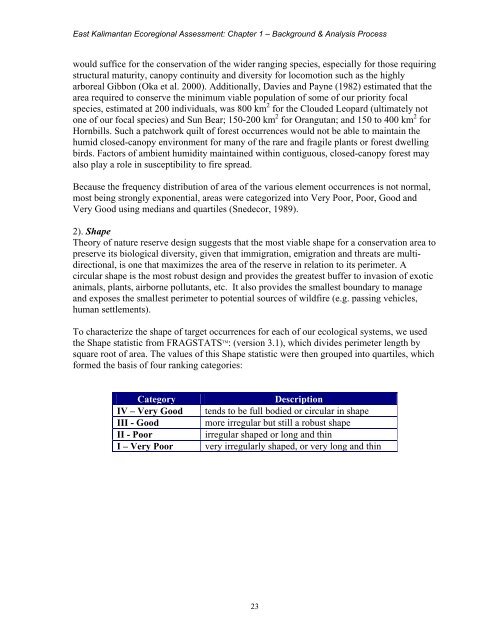Ecoregional Assessment of Biological Diversity in East Kalimantan
Ecoregional Assessment of Biological Diversity in East Kalimantan
Ecoregional Assessment of Biological Diversity in East Kalimantan
You also want an ePaper? Increase the reach of your titles
YUMPU automatically turns print PDFs into web optimized ePapers that Google loves.
<strong>East</strong> <strong>Kalimantan</strong> <strong>Ecoregional</strong> <strong>Assessment</strong>: Chapter 1 – Background & Analysis Process<br />
would suffice for the conservation <strong>of</strong> the wider rang<strong>in</strong>g species, especially for those requir<strong>in</strong>g<br />
structural maturity, canopy cont<strong>in</strong>uity and diversity for locomotion such as the highly<br />
arboreal Gibbon (Oka et al. 2000). Additionally, Davies and Payne (1982) estimated that the<br />
area required to conserve the m<strong>in</strong>imum viable population <strong>of</strong> some <strong>of</strong> our priority focal<br />
species, estimated at 200 <strong>in</strong>dividuals, was 800 km 2 for the Clouded Leopard (ultimately not<br />
one <strong>of</strong> our focal species) and Sun Bear; 150-200 km 2 for Orangutan; and 150 to 400 km 2 for<br />
Hornbills. Such a patchwork quilt <strong>of</strong> forest occurrences would not be able to ma<strong>in</strong>ta<strong>in</strong> the<br />
humid closed-canopy environment for many <strong>of</strong> the rare and fragile plants or forest dwell<strong>in</strong>g<br />
birds. Factors <strong>of</strong> ambient humidity ma<strong>in</strong>ta<strong>in</strong>ed with<strong>in</strong> contiguous, closed-canopy forest may<br />
also play a role <strong>in</strong> susceptibility to fire spread.<br />
Because the frequency distribution <strong>of</strong> area <strong>of</strong> the various element occurrences is not normal,<br />
most be<strong>in</strong>g strongly exponential, areas were categorized <strong>in</strong>to Very Poor, Poor, Good and<br />
Very Good us<strong>in</strong>g medians and quartiles (Snedecor, 1989).<br />
2). Shape<br />
Theory <strong>of</strong> nature reserve design suggests that the most viable shape for a conservation area to<br />
preserve its biological diversity, given that immigration, emigration and threats are multidirectional,<br />
is one that maximizes the area <strong>of</strong> the reserve <strong>in</strong> relation to its perimeter. A<br />
circular shape is the most robust design and provides the greatest buffer to <strong>in</strong>vasion <strong>of</strong> exotic<br />
animals, plants, airborne pollutants, etc. It also provides the smallest boundary to manage<br />
and exposes the smallest perimeter to potential sources <strong>of</strong> wildfire (e.g. pass<strong>in</strong>g vehicles,<br />
human settlements).<br />
To characterize the shape <strong>of</strong> target occurrences for each <strong>of</strong> our ecological systems, we used<br />
the Shape statistic from FRAGSTATS TM : (version 3.1), which divides perimeter length by<br />
square root <strong>of</strong> area. The values <strong>of</strong> this Shape statistic were then grouped <strong>in</strong>to quartiles, which<br />
formed the basis <strong>of</strong> four rank<strong>in</strong>g categories:<br />
Category<br />
IV – Very Good<br />
III - Good<br />
II - Poor<br />
I – Very Poor<br />
Description<br />
tends to be full bodied or circular <strong>in</strong> shape<br />
more irregular but still a robust shape<br />
irregular shaped or long and th<strong>in</strong><br />
very irregularly shaped, or very long and th<strong>in</strong><br />
23

















